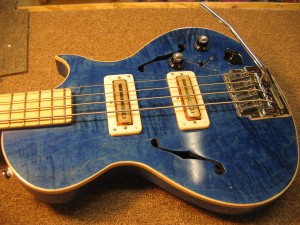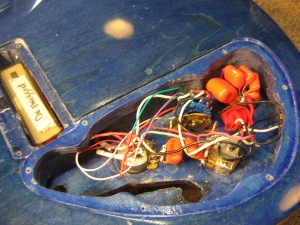Okay Blueshawk fans, we know what you’re thinking; there’s no such thing as a Blueshawk bass. Well, thanks to a tag-team effort, there is now. This was truly one of the most challenging electronics customization projects we’ve ever done and it turned out great. **Beware** though, this one gets technical!
First, a little background on what makes the Gibson Blueshawk so unique. The original design calls for a pair of P-90 pickups with a three position pickup selector. Simple enough, but here’s where it gets interesting. Anyone who has played P-90 pickups knows what Strat and Tele players know – single coil pickups hum. But when combined with another pickup that is wound in reverse with opposite polarity of their magnets, they cancel that hum. Hence the quiet 2 and 4 positions on a Strat switch. The Blueshawk design uses a third pickup that is reverse-wound, demagnatized, and mounted in the back of the instrument (pictured above with a piece of tape that reads ‘demagged’.) In combination with either of the top pickups, this third “dummy” coil cancels the hum in the same way the second coil of a humbucking pickup does but has no effect on the original tone of the pickups.
So your three hum-cancelling pickup positions are: 1. Neck pickup with dummy coil 2. Neck pickup and Bridge pickup 3. Bridge pickup with dummy coil. Throw in a 5 position variatone switch with a push/pull bypass option, and you’ve got a system that is complicated in design, but simple and smart in it’s operation.
“But Gibson never made a Blueshawk bass!”
That’s true, but our customer John did. He loved the idea of a bass that utilized this unique electronics scheme and liked the look of the Blueshawk. So he built himself this body and joined it to an old Gibson Ripper bass neck. That sounds easier than it really is. Good work John. We loved how he made the interesting choice of adding a Kahler vibrato bridge to this bass. What he wanted from us was to get the electronics working the way they should.
But the switch John bought online didn’t match the one in the schematics he found. So essentially, we had to create our own wiring to match the many functions he wanted on an oversized switch that wasn’t made for this job. Jim Respass who designs Stress FX effects pedals we carry here scrubbed in and helped interpret the schematic. After a lot of head scratching, soldering, desoldering, and soldering again, together we got it working. We made one modification to the original design by removing a treble bleed function where some of the treble tones of the bridge pickup are removed in the middle switch position. It just sounded dull. So we took that function out, refretted the 30 year old Ripper neck, and now John’s got himself a one-of-a-kind bass that plays, sounds, and looks terrific.




Hey, nice MacGyvering! But what were the “many functions” that John wanted? And is there any chance of posting the final wiring diagram, just in case some other adventurous soul wants to try this kind of soldering madness at home?
The ‘many functions’ are simply all of the operations that have to happen in each of the switch positions of this design. For example, in the first position, the north side of the neck pickup must be sent to the hot signal and the south side to ground. At the same time, the dummy coil must be engaged and the bridge pickup disengaged. In the middle position, the south side of the neck pickup must be hot and the north side grounded with the dummy coil disengaged and the north side of the bridge hot with the south side ground. There’s just a lot going on. The version of the schematic that worked best for us can be found at: http://www.blueshawk.info/circuit_diagram.htm
hey is anyone out there making blueshawk replicas? cause i want one!